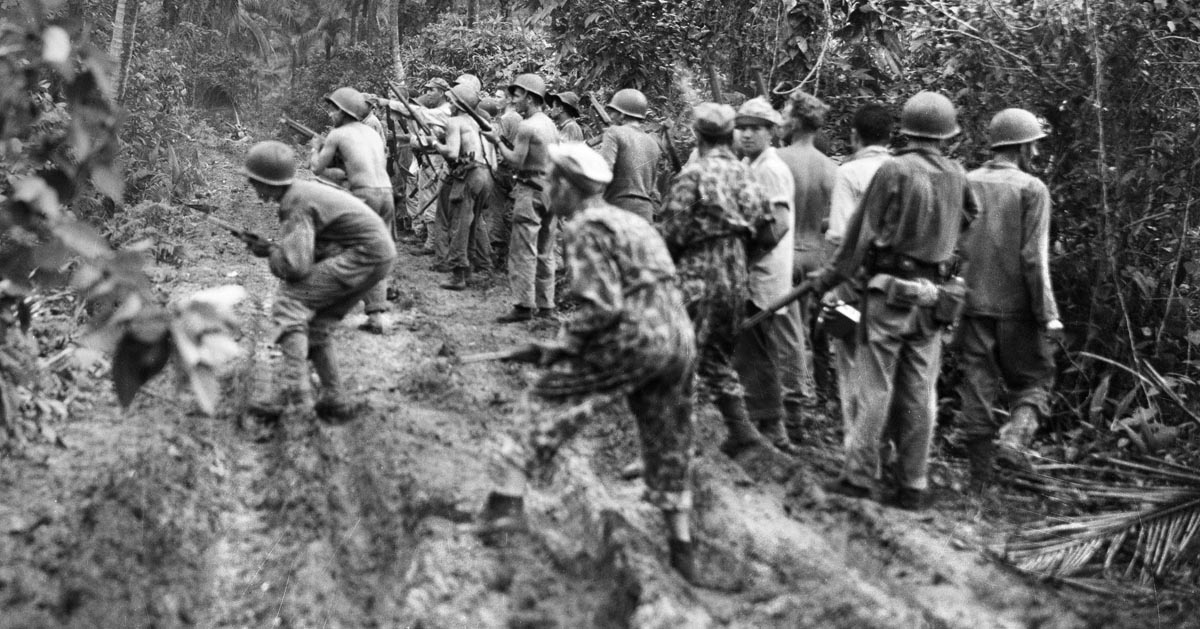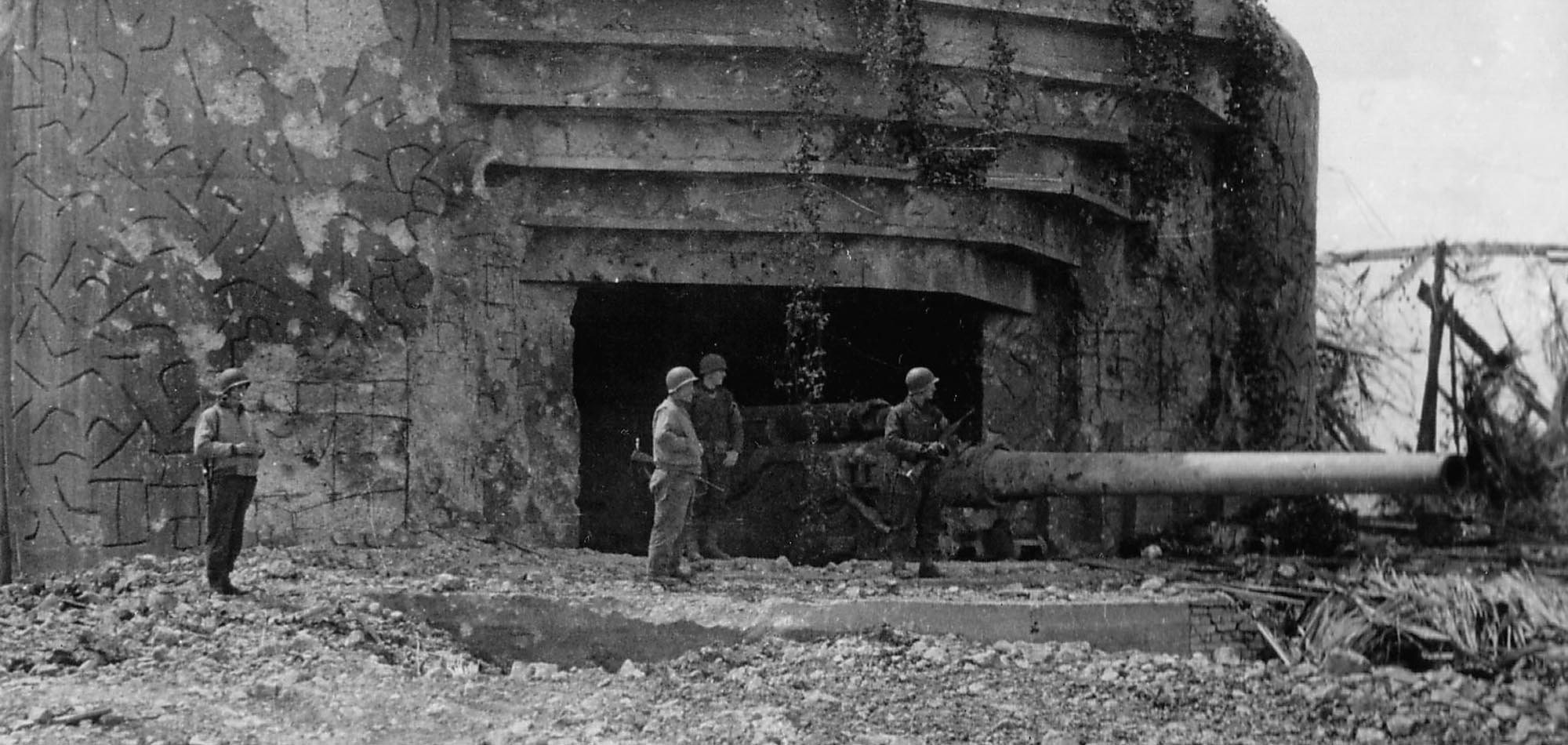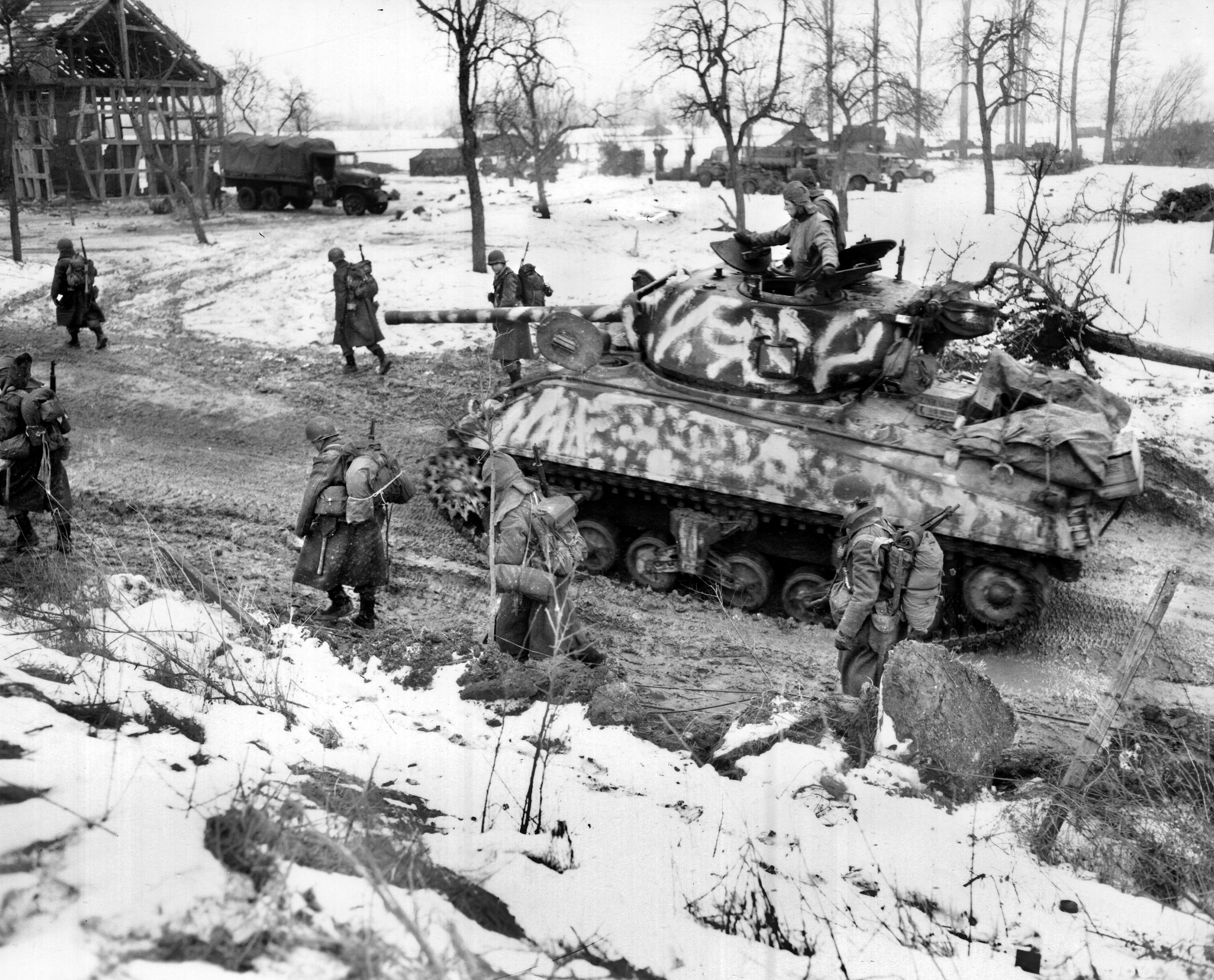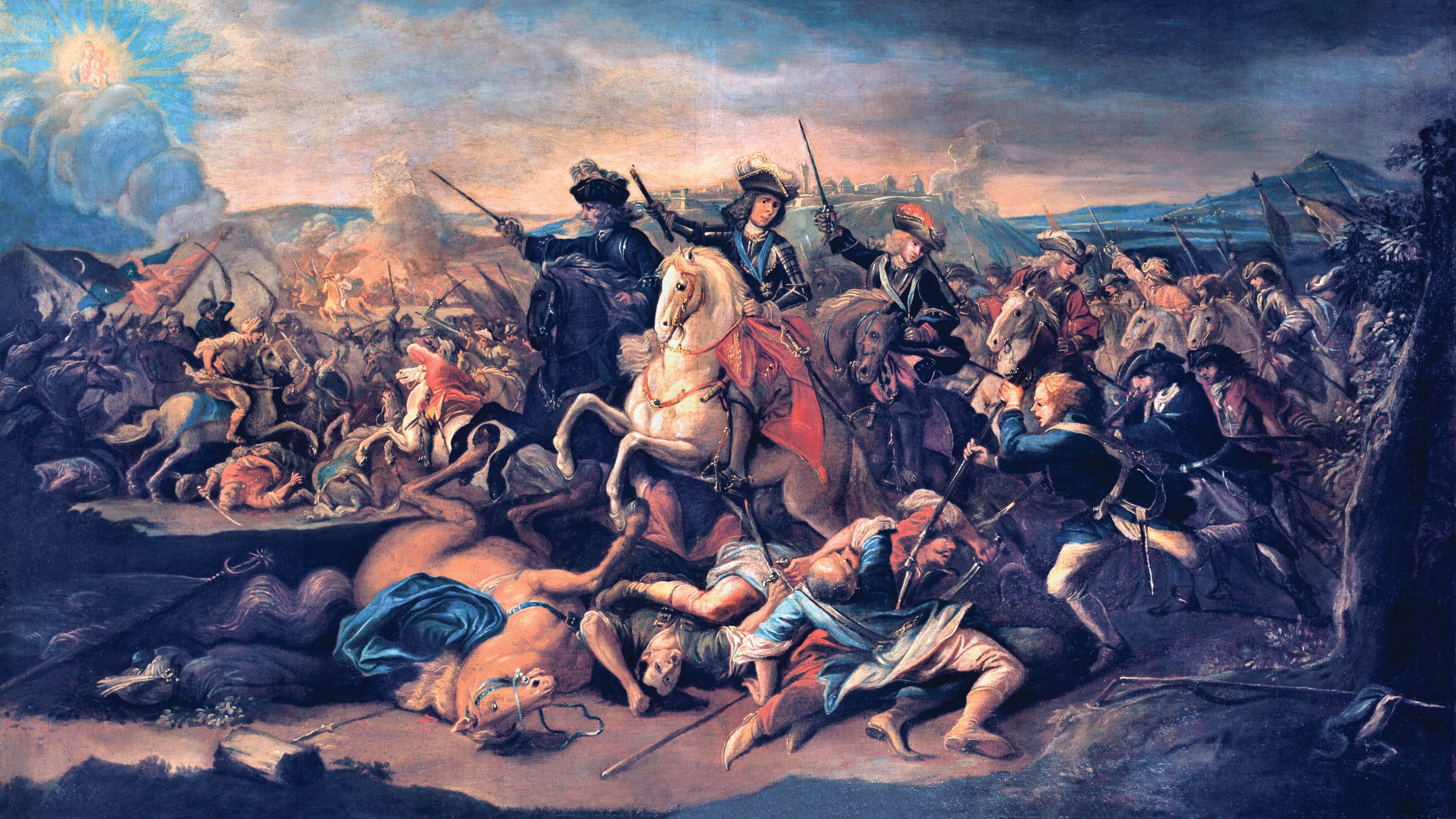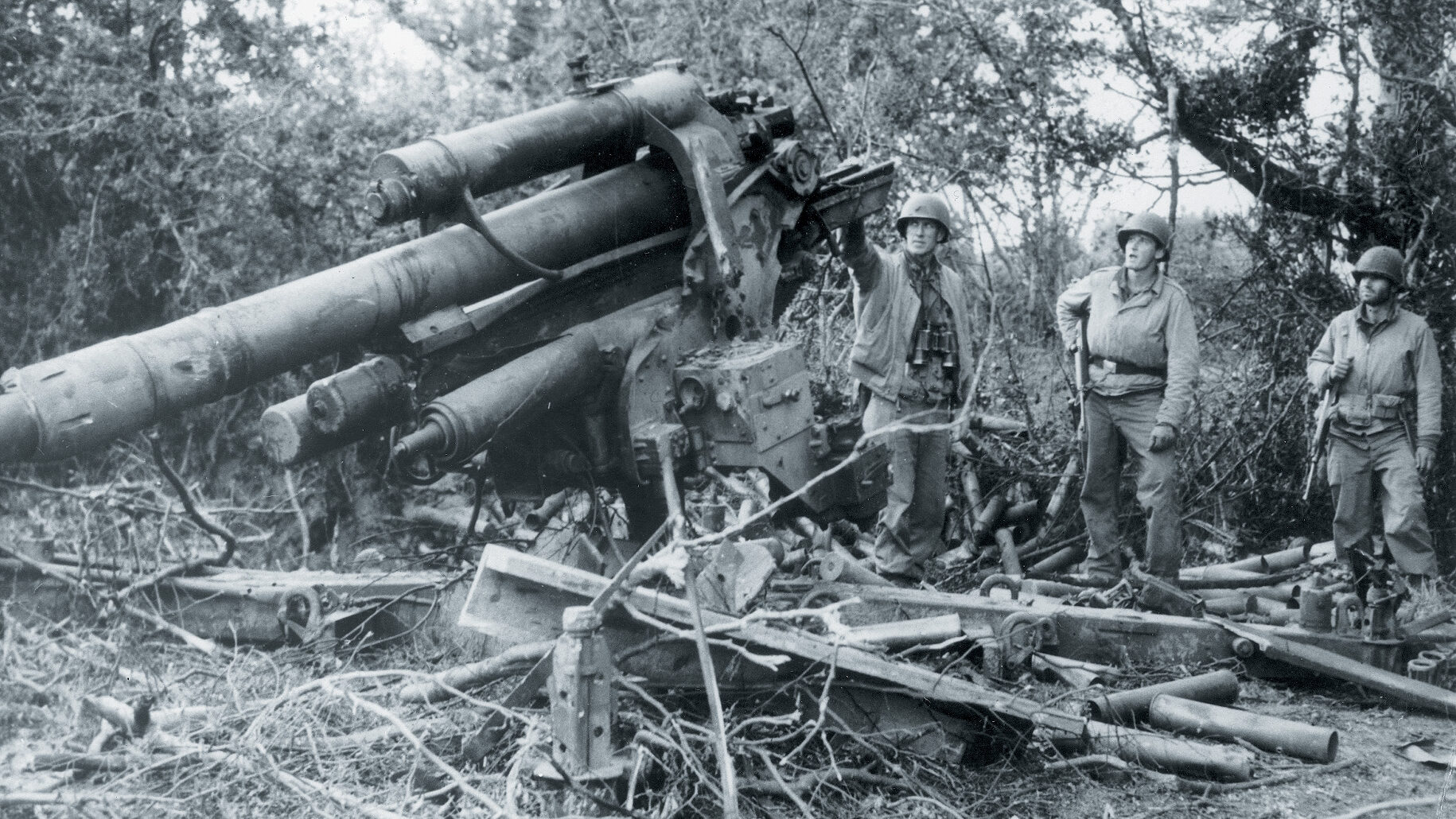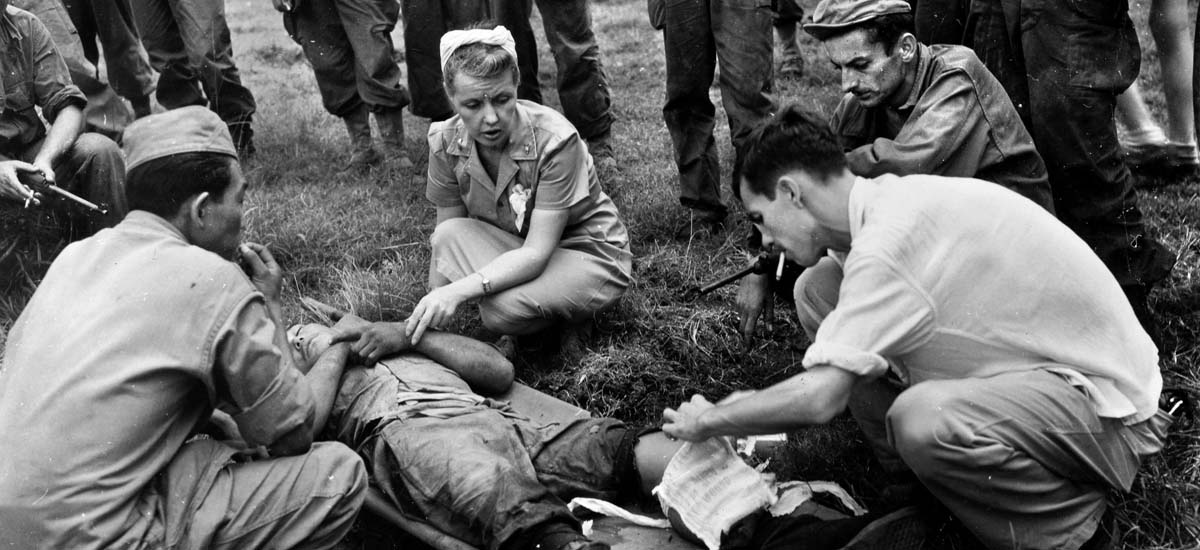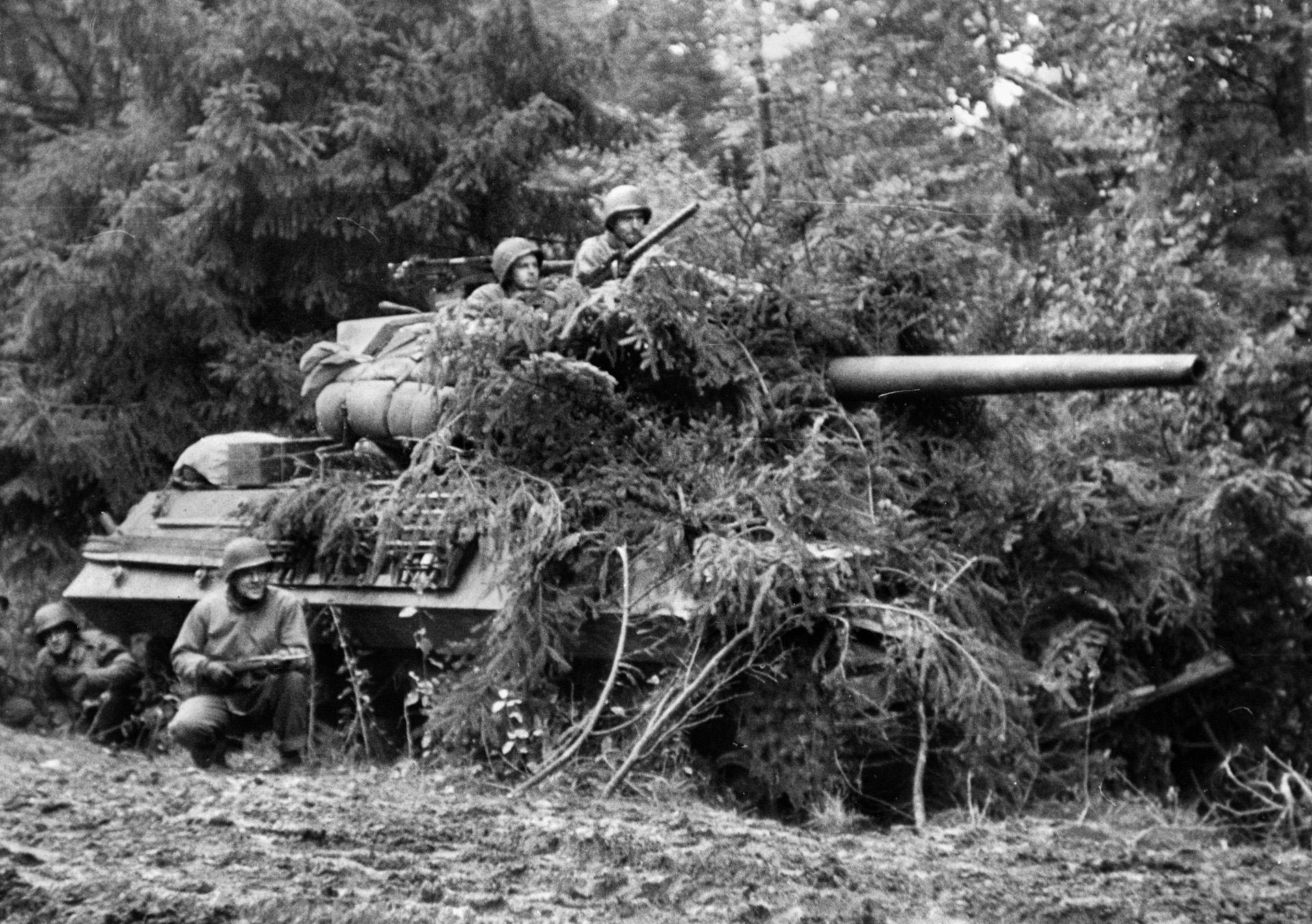By Patrick J. Chaisson
General Douglas MacArthur gripped the rail of the light cruiser USS Phoenix as the warship bombarded shore positions on the Japanese-held island of Los Negros. Alongside him stood Vice Admiral Thomas C. Kinkaid, whose Seventh Fleet was then putting 1,000 U.S. soldiers onto this strategic Pacific outpost.
Without warning, return fire from Los Negros began landing all around the Phoenix. One projectile exploded just 200 yards away. As his flagship delivered a deafening broadside in response, MacArthur recalled that the last time he experienced such close-in enemy shellfire had in the Meuse-Argonne during World War I, a full quarter century earlier.
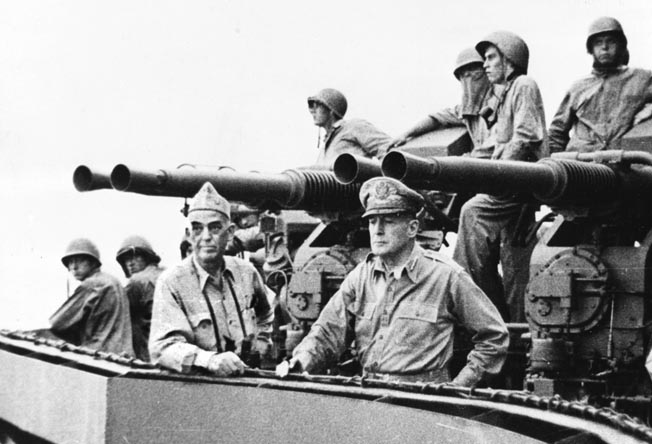
Yet the Los Negros landings, which took place in February 1944, started off relatively well for the Americans. Kinkaid’s fleet quickly silenced pesky shore batteries, while hard-charging GIs took their objective—Momote Airfield—only 95 minutes after the first waves touched down. In mid-afternoon, General MacArthur went ashore to see for himself how this so-called “reconnaissance-in-force” was progressing.
After a quick tour of the front lines, MacArthur met with his senior Army commander on Los Negros, Brig. Gen. William C. Chase of the U.S. First Cavalry Division. He then made a momentous decision. Ordering Chase to “to remain here and hold the airstrip at any cost,” the general transformed what was meant to be a low-risk raid into an all-out invasion. He did so without knowing the full tactical picture. There were far more Japanese on the island than some Allied officers had predicted—in fact, they greatly outnumbered their American adversaries.
That evening, MacArthur returned to his flagship and sailed off for an Allied base on New Guinea. Accompanying Phoenix was the light cruiser USS Nashville and all but two destroyers of Admiral Kinkaid’s invasion fleet. This meant Chase’s inexperienced cavalry troopers would enter battle on Los Negros armed only with what they had brought with them and a mere fraction of the naval gunfire support deemed necessary to back an island assault.
The Japanese waited for full darkness to begin their probing attacks. Some soldiers tossed hand grenades into American foxholes, while others stealthily crept through the lines. Just before sunup, two infiltrators were found and killed scant feet from General Chase’s command post (CP).
Weary U.S. cavalrymen greeted the dawn on March 1 by counting the ammunition remaining in their cartridge belts. They also counted 66 enemy bodies killed in the previous night’s fight before starting the arduous task of clearing snipers from their narrow beachhead. It promised to be a long day.
From captured documents, Brig. Gen. Chase realized that more than 4,400 Japanese opposed him on Los Negros and neighboring Manus Island. He could not know, however, that their commanding officer was even then organizing a full-scale counterattack intended to annihilate the lightly equipped invaders. Could Chase’s troopers hold out long enough for reinforcements to arrive? Or was Los Negros destined to become another infamous “last stand” for the U.S. Cavalry?
As supreme commander of the Southwest Pacific Area (SWPA), Douglas MacArthur kept his land, sea, and air forces extraordinarily active throughout the winter of 1943-1944. On December 15, 1943, American troops stormed ashore at Arawe on the southern tip of New Britain. Eleven days later, U.S. Marines landed farther up New Britain’s northwestern coast at Cape Gloucester to seize vital airfields there. On January 2, 1944, the Allies made another amphibious assault at Saidor on New Guinea, their objective again a vital airstrip.
These actions were all part of Operation Cartwheel, a major campaign designed to overwhelm Japanese air and naval installations at Rabaul, New Britain. Since the start of the Pacific War, Rabaul—boasting a large harbor and network of airdromes—served as the center of enemy activity throughout eastern New Guinea and the Solomon Islands. Allied forces could not safely advance without first neutralizing this threat to their own lines of communication.
Once MacArthur’s hard-working engineers finished lengthening the runways on Arawe, Cape Gloucester, and Saidor, Rabaul fell well within the operational range of U.S. medium bombers and their fighter escorts. Slowly, inexorably, Allied airpower began choking off the Rabaul garrison’s ability to defend itself and receive supplies.
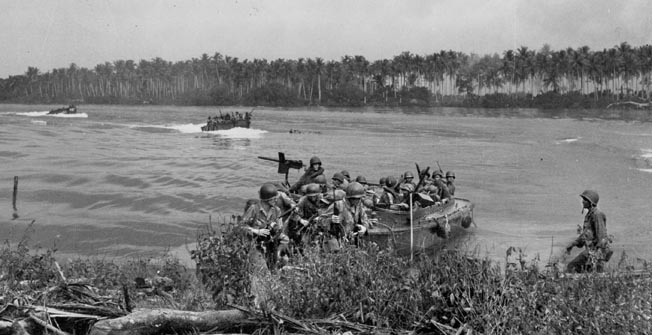
The primary architects of this aerial campaign were two aggressive aviators, Lt. Gen. George C. Kenney and Maj. Gen. Ennis C. Whitehead. Kenney, who commanded the U.S. Fifth Air Force, and Whitehead, his deputy, recognized that the vast distances and resource constraints across the SWPA presented ideal conditions in which to prove a new form of warfare. Both airmen believed the Allies could defeat their enemy without resorting to costly land battles. Rather, strike aircraft would sink every freighter in Rabaul’s harbor and render useless all of its airfields. The Japanese would be left isolated and paralyzed, no matter how many troops they had under arms.
A ground commander by training and experience, MacArthur began to embrace the new capabilities that his air and naval arms were bringing to the fight. By January 1944, Rabaul’s garrison of 98,000 Japanese had been left to “wither on the vine” by Kenney and Whitehead’s relentless aerial attacks. And Kinkaid was growing into his new role as head of the Seventh Fleet, nicknamed “MacArthur’s Navy.”
The Seventh Fleet was a formation like none other in history. Lacking the armada of fleet aircraft carriers and battlewagons in Admiral Chester Nimitz’s Central Pacific Area, Kinkaid made do with smaller, more adaptable task groups designed to rapidly put invasion forces ashore and keep them there. The sailors of MacArthur’s Navy relied on a bewildering array of shallow-bottomed landing craft and destroyer transports (APDs in naval terminology) to carry assault troops and their gear all across the Southwest Pacific.
By the first week of February, Rabaul had become a “self-feeding prisoner of war camp,” as described by one Allied officer. General MacArthur’s gaze now turned to the Admiralty Islands at the northwest end of the Bismarck Archipelago. Seizing the Admiralties meant accomplishing two key Allied objectives. First, it would cut the last remaining air and sea lanes connecting Rabaul with Japanese bases farther to the west. Second, an excellent though undeveloped harbor there could be transformed into a major staging base for MacArthur’s long-anticipated return to the Philippines.
For the Admiralty Islands invasion, SWPA planners set a tentative date of April 1, 1944. Staff officers then began the methodical task of gathering data on terrain, weather, and opposing forces. They learned the Admiralties stood 360 miles west of Rabaul and about 500 miles from the nearest Allied bases on New Guinea. There were two major islands, Manus and Los Negros, which together formed the arc of Seeadler Harbor—chief objective of the Allied operation.
Manus was the larger of the two. Resembling an ellipse, it measured approximately 49 miles long by 16 miles wide. A central mountain spine bisected this land mass, which was heavily jungled and unpopulated except along its northern coast. Separated from Manus by a narrow strait, the horseshoe-shaped island of Los Negros stretched 15 miles from end to end. Rugged terrain distinguished Los Negros’s southerly regions, but flat land to the north held promise for future airbase construction.
Together, Manus and Los Negros framed a natural anchorage known as Seeadler Harbor. Six miles wide, 20 miles long, and with a depth of 120 feet, Seeadler was large enough to shelter an entire invasion fleet. A string of barrier islands—Koruniat, Ndrilo, Hauwei, and Pityilu—guarded the roadstead and its likely landing beaches.
Holding the Admiralty Islands was a collection of Imperial Japanese Army and Navy outfits commanded by Colonel Yoshio Ezaki of the 51st Transport Regiment. Ezaki’s defenders included two understrength infantry battalions from the 1st Independent Mixed Regiment and the 229th Infantry Regiment as well as sailors belonging to the 14th Naval Base Force who guarded Seeadler Harbor with coast artillery positioned on its barrier islands. Total enemy strength exceeded 4,450 combatants.
The Japanese constructed two airdromes, one at Momote Plantation on Los Negros and a smaller strip near the village of Lorengau on Manus. They had, however, let these runways fall into disrepair after the Fifth Air Force stepped up its bombing campaign in February. Once Colonel Ezaki realized the Admiralties garrison was indeed marooned, he ordered his men to conceal their numbers, locations, and activities from American reconnaissance aircraft.
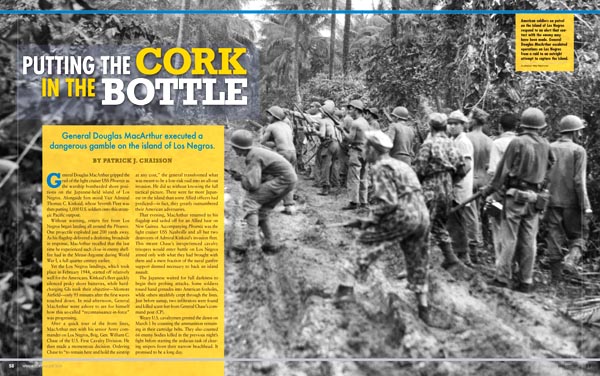
Ezaki’s scheme worked brilliantly. On February 23, three B-25 Mitchell bombers from the 17th Photographic Reconnaissance Squadron flew lazily over Los Negros for 90 minutes without drawing antiaircraft fire or observing any other signs of enemy occupation. The entire area looked “completely washed out,” pilots later reported to General Whitehead in New Guinea. “Crews say Los Negros and Manus are evacuated.”
Whitehead immediately passed these reports on to Kenney in SWPA’s Brisbane, Australia, headquarters, along with an unsubstantiated estimate of 300 Japanese soldiers remaining in the Admiralty Islands. Early on the morning of February 24, General Kenney took this news upstairs to his boss. “Los Negros,” Kenney claimed, “was ripe for the plucking.”
Ever alert to a strategic opportunity, MacArthur listened intently as Kenney outlined his plan. The aviator proposed sending 800 troops, a “reconnaissance-in-force,” out to the Admiralties to occupy Los Negros long enough to ascertain whether or not the Momote airfield was indeed deserted. If Whitehead’s information proved correct, this detachment should then immediately go on to seize Manus and its outlying barrier islands. Kenney also suggested sending in a small surveillance element ahead of the main body to confirm his aircrews’ observations.
MacArthur paced the floor, considering Kenney’s proposal. Finally, he halted and exclaimed, “That will put the cork in the bottle!” The supreme commander then summoned to his office SWPA’s operations officer and Admiral Kinkaid. “We’re going to the Admiralty Islands,” he told them, “and we go on Leap Day (29 February).” It was a dramatic moment in a headquarters known for its commanding general’s often dramatic presence.
The next morning, February 25, orders went out to all subordinate Army, Navy, and air commanders: “Land on [Los Negros Island] in the vicinity of [Momote airfield] and make immediate reconnaissance in force to determine the enemy strength and disposition.”
This directive surprised many officers, but none more so than Lt. Gen. Walter Krueger of the Sixth U.S. Army. Krueger wore two hats in the SWPA; aside from his responsibilities as head of Sixth Army he also commanded Alamo Force, which coordinated American ground operations in theater. As such, this career officer supervised the planning of every amphibious operation that MacArthur wanted accomplished.
Four days was not a lot of time to move 1,000 men (Krueger persuaded MacArthur to raise the total number of troops from his original 800), but much preliminary planning had already been conducted. Krueger staged soldiers at bases near Oro Bay, New Guinea, while Kinkaid managed to assemble a flotilla of APDs and fleet destroyers to transport them 500 miles to Los Negros. Reinforcements could be expected to arrive on slower moving Landing Ships, Tank (LSTs) two days after the reconnaissance element made its landing.
Sixth Army intelligence officers questioned the Air Corps’ claim that Los Negros and Manus had been abandoned. Their own sources showed that 4,500 Japanese still held on to the Admiralty Islands. Therefore, before dawn on February 27, a six-man team from the elite Alamo Scouts set out in a U.S. Navy PBY Catalina flying boat to evaluate the enemy situation on Los Negros and report back its findings.
Paddling ashore in a rubber raft, the Alamo Scouts then cautiously made their way through dense jungle toward Momote airdrome. Signs of Japanese occupation were everywhere. After evading several infantry patrols, the team turned around short of its objective and went to ground. That night its leader radioed in a brief but telling message: “The area is lousy with Japs.”
Back in Brisbane, General Kenney discounted the scout team’s report as the product of a frightened young lieutenant’s imagination. Besides, the invasion fleet was already halfway to Los Negros with a quite senior commander accompanying it. Douglas MacArthur felt strongly that he alone should decide whether to continue to attack or withdraw. Only by seeing things on the ground, MacArthur reasoned, could he make an informed choice.
Nevertheless, MacArthur’s hastily organized “reconnaissance-in-force” carried with it some tremendous risks. Amphibious doctrine required a three to one ratio of attackers versus defenders, which explains his decision to send 1,000 men up against the 300 defenders that SWPA’s air staff believed still occupied Los Negros and Manus. In reality, however, there were four Japanese for every American set to make this dangerous invasion. Worse still, those GIs completely lacked battle experience.
Troopers of the First Cavalry Division left their horses behind when, in the summer of 1943, they deployed to Australia. There the outfit was reconfigured under a hybrid table of organization. Retaining traditional cavalry unit designations (squadron for battalion, troop for company, etc.), the division armed and trained itself to fight as infantry. Restless months spent in Australian training camps had left the division’s men eager for a brawl. They would soon get one.
The First Cavalry Division (Special) was commanded by Maj. Gen. Innis P. Swift, who like many of his men had served in the prewar cavalry. His two brigade commanders, Brig. Gens. William C. Chase and Verne D. Mudge, each led about 4,000 dismounted horse soldiers. Field artillery, engineer, signal, medical, and service support elements rounded out the division’s 15,000-man combat strength.
For the Los Negros mission, General Chase selected the 2nd Squadron, 5th Cavalry Regiment to form the backbone of his assault element. Two 75mm pack howitzers from the 99th Field Artillery went along to provide fire support, while a dozen .50-caliber machine guns crewed by the 673rd Antiaircraft Machine Gun Battery covered the skies. Chase’s 1,026-man detachment also included naval and air liaison teams, communications personnel, and recon scouts, as well as medical aidmen from the 30th Portable Surgical Hospital.
Task Force Brewer (code name for this “reconnaissance-in-force”) arrived off Jamandilai Point along Los Negros’s east coast before dawn on February 29, 1944. Under a steady rain, U.S. Navy cruisers and destroyers began bombarding the shore while cavalry troopers loaded into Landing Craft Personnel, Ramp (LCPRs) for the ride in. They were headed for Hyane Harbor, a narrow channel just off Momote’s runway and far from—it was hoped—Japanese coastal defenses.
Colonel Ezaki’s men were caught entirely by surprise. Stunned by naval shellfire and a barrage of 500-pound bombs dropped by B-25s of the 345th Bomb Group, “Air Apaches,” most of the Japanese holding this sector could only cower in their foxholes. Task Force (TF) Brewer’s first wave touched down unopposed on White Beach at 0817 hours, two minutes behind schedule.
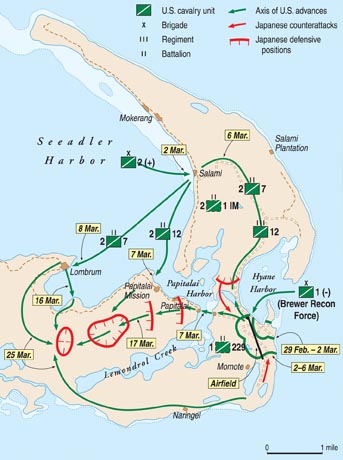
Ezaki’s defenders quickly recovered from their initial shock, though, and soon began shooting back at the approaching LCPRs. Subsequent waves encountered fierce return fire; U.S. destroyers struggled to find and destroy these hidden gunners, obscured as they were by a tropical downpour. Corporal Bill Alcine, a correspondent for Yankmagazine, vividly recounted his run into the beach: “As we neared the channel, the Navy men in the bow hollered to us to keep our heads down or we’d get them blown off. We crouched lower, swearing, and waited.”
“It came with a crack,” Alcine’s account continued, “machine gun fire over our heads. Our light landing craft shuddered as the Navy gunners hammered back and answered with the .30-calibers mounted on both sides of the barge.”
The troopers aboard Alcine’s LCPR “piled out quickly at the beachhead” and went to work. Cavalry platoons advanced rapidly across Momote airfield and 300 yards into the undergrowth beyond. By 0950 they had taken their initial objectives. A few hours later, General Chase’s task force finished unloading all men and supplies. For the cost of two soldiers killed and another three wounded, the Americans had established a toehold on Los Negros. But could they stay there?
Strewn all around them was evidence of a strong enemy presence, including several hastily vacated bivouac areas found about one mile south of the beach. Other patrols carefully investigated a network of bunkers, dugouts, and trenches scattered throughout the Momote perimeter.
Papers seized in one command bunker indicated there were as many as 200 Japanese antiaircraft gunners assigned to protect this sector of Los Negros. Most of them had run away when the shooting started, but they would be back once Colonel Ezaki organized a counterattack. For now, the only resistance consisted of occasional nuisance fire from a few stay-behind riflemen.
These skirmishers were still at it when General MacArthur toured the front lines later that afternoon. A cavalry lieutenant, concerned for his chief’s safety, gestured toward one enemy hideout while tugging on the general’s sleeve. “Excuse me, Sir,” the young officer warned, “but we killed a sniper in there just a few minutes ago.”
Unperturbed, the supreme commander replied, “Fine, that’s the best thing to do with them.” His remark spread quickly throughout the ranks, affording everyone on Los Negros a much needed chuckle. But the cavalrymen would need all the spirit they could muster, as shortly thereafter they received orders to dig in. MacArthur had made his decision: TF Brewer would “continue the assault.”
Wisely, General Chase ordered his men to form a compact 1,500-yard night perimeter along Momote airstrip’s western edge. The troops had no barbed wire, and their entrenching tools proved useless against Los Negros’s hard coral surface. The task force’s dozen .50-calibers, intended for air defense, went up on the line to cover likely avenues of advance. And with no room to emplace their howitzers, artillery crews filled in as infantry. Offshore, destroyers Bushand Stocktonstationed themselves to provide fire support for the cavalry task force.
The Japanese possessed a golden opportunity to push their “arrogant enemy” back into the sea, provided that Colonel Ezaki could launch a counterattack before U.S. reinforcements arrived. While most of his defenders were badly situated for a thrust against Hyane Harbor, Ezaki’s 1st Battalion, 229th Infantry held a key position north of Momote airstrip. At dusk he sent this order: “Tonight, the battalion under Cpt. Baba will annihilate the enemy who have landed. This is not a delaying action. Be resolute to sacrifice your life for the Emperor and commit suicide in case capture is imminent. We must carry out our mission with the present strength and annihilate the enemy on the spot.”
Had Baba been able to concentrate his efforts and punch through the inexperienced Americans’ line, things might have gone much differently on Los Negros. Instead, he dissipated his combat power in an uncoordinated series of small, probing skirmishes. Together with a near constant stream of individual raiders, these intruders kept the troopers of TF Brewer awake all night but never seriously threatened General Chase’s hold on the Momote perimeter.
There were, however, a few harrowing moments when Japanese troops followed U.S. communication wires back to the task force CP. Chase’s intelligence officer, Major Julio Chiarmonte, heard two infiltrators whispering outside his dugout and dispatched both of them with a Thompson submachine gun.
The GIs knew enough to stay put after dark, shooting or grenading anything that moved. Private Walter E. Hawks of Troop E used his Browning Automatic Rifle to kill eight approaching machine gunners. Later, Hawks waited until a group of 20 charging infantrymen got to within 15 feet of his hole before mowing down the lot of them.
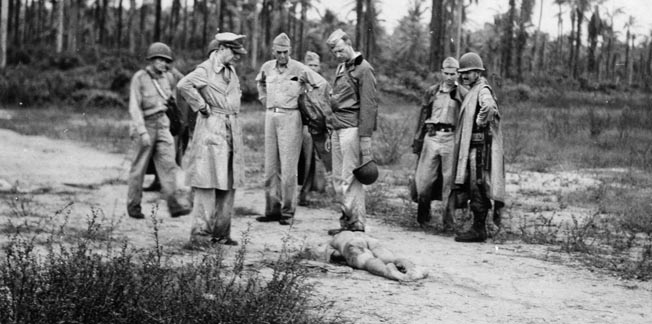
Better weather on March 1 allowed Fifth Air Force to resupply the beachhead with more than three tons of ammunition and blood plasma dropped from B-17 Flying Fortresses of the 375th Troop Carrier Group. Also flying overhead, B-24 Liberator and B-25 Mitchell bombers pummeled the foe’s staging areas, especially a narrow spit of land just north of the airfield where natives once dragged their canoes from Hyane to Seeadler Harbor. This so-called “native skidway” measured only 50 yards across and acted as a choke point that channeled attacking troops into a deadly kill zone.
Wary cavalrymen devoted the day to “disinfecting” their lodgment of any last remaining infiltrators. Around 1600 hours there was a bit of excitement when another Japanese raiding party broke through and headed for General Chase’s CP. Again, Major Chiaramonte and his Tommy gun helped wipe out the entire 15-man patrol, one of whom was later discovered to be Captain Baba.
With their captain now dead, the Japanese displayed markedly less fighting spirit during the night of March 1. This did not stop a squad of riflemen from sneaking up on Private Andrew R. Barnabei of Battery B, 99th Artillery. Hearing unfamiliar voices outside his foxhole, Barnabei calmly lobbed a fragmentation grenade that killed all five intruders.
Morale soared among the men of TF Brewer when at 0900 hours on March 2 six LSTs and nine destroyers appeared off Jamandilai Point. Under steady mortar and light machine-gun fire, 1,500 troopers from the 1st Squadron, 5th Cavalry Regiment and 99th Field Artillery Battalion came ashore, unloaded, and marched straight into combat. Meanwhile, bulldozer-equipped Army construction engineers and Navy Seabees of the 40th Naval Construction Battalion (NCB) began improving White Beach for future operations.
A courier brought General Chase more good news. The entire First Cavalry Division was on its way to Los Negros. Until those forces arrived, though, his mission was to hold Momote at all costs. Chase’s freshly arrived reinforcements helped even the odds, but victory remained a long way off. And Colonel Ezaki still had a powerful surprise in store for the American invaders.
The soldiers of Ezaki’s 2nd Battalion, 1st Independent Mixed Regiment, commanded by a Captain Iwakami, took longer than expected to gather at their attack position north of the native skidway. Allied airstrikes and naval gunfire obliged them to travel from their garrisons across Manus and on the barrier islands mostly during the hours of darkness. Thus, it was not until late on March 3 that Iwakami’s men began readying themselves for the climactic battle for Los Negros.
By that time TF Brewer had extended its perimeter completely across Momote airdrome. A fresh squadron of cavalrymen was dug in to the left, or south, where General Chase expected the main enemy attack to occur. The 2nd Squadron, exhausted after four nights of near constant fighting, covered the skidway and northern approaches.
Directly behind 2nd Squadron the Seabees had dug a long defensive trench. They would occupy it when ordered, backstopping the cavalry. Nearer the beach, a full 18-gun field artillery battalion executed close-in fire missions while Australian and American destroyers standing offshore hammered suspected Japanese troop concentrations.
The encounter started in an unusual way. At 2100 hours a Japanese plane buzzed the perimeter, dropping eight bombs that severed phone lines and drove many troopers deep into their foxholes. Then two signal flares shot into the sky, and Iwakami’s battalion surged forward.
Frenzied infantrymen hurled themselves across the skidway, which was now well covered by mortars, machine guns, and artillery. Many soldiers fell to mines and booby traps, while others were slaughtered by ferocious defensive fire. Whenever one wave of Iwakami’s attackers stalled, though, another soon took its place. By midnight the weight of Japanese numbers began to tell.
Troop G took the brunt of their fury. Sergeant Troy A. McGill and his squad of eight troopers held a revetment against repeated assaults; by 0400 all but one of McGill’s men had been killed, and that individual was badly wounded. Sending his comrade to the rear, the sergeant then singlehandedly resisted an onslaught by what was later estimated to be 200 Japanese. McGill, clutching his rifle like a club, was found dead in the midst of 130 enemy corpses. For this valorous act he received a posthumous Medal of Honor.
Automatic weapons proved decisive in this ugly brawl. The First Cavalry Division history reported that Troop G’s Staff Sergeant Clarence D. Sparks “fired his machine gun … until it burned out…. Sparks [then] crawled to the rear and procured a new gun which he brought forward and speedily placed into action at his original position.”
Iwakami’s men employed several ruses to bait the defenders. One English-speaking raider called out to Corporal Joseph Hodonsky, “How you doin’, Joe?” Hodonsky was doing fine, according to a Yankcorrespondent, shooting down the intruder with his .45 automatic.
Other enemy tricks worked better. Japanese infiltrators managed to tap the communication wires leading to 2nd Squadron’s heavy mortar platoon. Imitating a senior officer, they persuaded the green lieutenant in charge there to withdraw at the worst possible time. GIs eventually recaptured their mortars, but by then Iwakami’s forces had already pierced the perimeter.
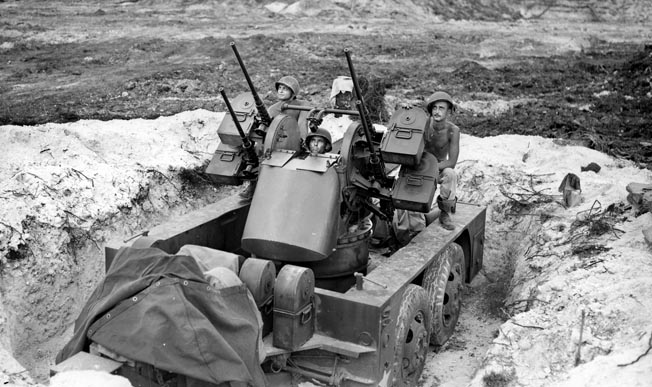
One hundred Seabees of the 40th NCB put down their tools and picked up rifles to occupy a secondary defensive position behind hard-pressed Troop G. When enemy infantrymen threatened to overwhelm their left flank, sailors began hauling ammo crates up to fast-firing U.S. Navy machine gunners. The Seabees held firm, even at one point launching a counterattack to help restore the line.
Meanwhile, several barges loaded with Japanese soldiers tried to slip into Hyane Harbor. Bright moonlight betrayed their approach, however, and these boats were destroyed in short order by antiaircraft cannons, artillery, and heavy machine guns.
The final enemy thrust took place just before dawn. A column of 50 Japanese troops, all reportedly singing “Deep in the Heart of Texas,” charged straight into a buzzsaw of heavy weapons fire west of the skidway. By 0730 Iwakami’s desperate effort had spent itself. “We hold entire perimeter,” General Chase radioed to Sixth Army headquarters later that morning. “Everything is under control.”
Indeed it was, although the GIs of TF Brewer paid a steep price for their nocturnal victory. Altogether, 61 Americans perished that night while another 244 were wounded. The Seabees alone suffered nine dead and 38 injured.
By the evening of March 4, U.S. troopers had counted and buried the bodies of 779 enemy combatants. Some 168 of them were found in front of Troop G’s position. A report captured afterward said that Colonel Ezaki lost 1,400 men during the action of March 3-4, 1944.
More U.S. reinforcements arrived that day, and on March 5, Maj. Gen. Swift came ashore to assume command of the Los Negros operation. By then, Hyane Harbor bustled with activity. Army and Navy construction engineers could be seen everywhere, working hard to improve port facilities and rehabilitate Momote airdrome for Allied use. Service units established ever expanding supply dumps, while medical teams tended to those wounded in action.
MacArthur’s forces were on Los Negros to stay. At sunup on March 6, a total of 4,000 men of the First Cavalry Division kicked off an attack. Troopers rapidly seized the native skidway, now clogged with the decomposing remains of several hundred Japanese soldiers, and pushed on toward Seeadler Harbor.
That same morning a battle-damaged B-25 made an emergency landing on Momote airfield. Before long, Momote became home to Nos. 76 and 77 Squadrons, Royal Australian Air Force. Their Curtiss Kittyhawks, together with warplanes of the U.S. Fifth Air Force, day after day provided invaluable close air support to Allied ground forces then entering the campaign’s final phase.
On March 9, the remainder of Maj. Gen. Swift’s First Cavalry Division disembarked at a newly established beachhead along the western edge of Seeadler Harbor near Salami Plantation. Following a period of reorganization, they invaded Manus on March 15, 1944. Troopers steadily advanced toward the village of Lorengau while enduring torrential rains that turned jungle tracks into veritable quagmires of mud. It was a slow, grinding attack, one opposed by small groups of desperate Japanese soldiers who were determined to die fighting in their bunkers or from a sniper’s treetop perch.
More action awaited the division on Manus’s barrier islands, small, rocky outposts that had to be captured before Allied shipping could enter Seeadler Harbor. While several islets were left unoccupied, 45 holdouts from the Imperial Japanese Navy strongly garrisoned Hauwei. These gunners ambushed an unwary reconnaissance team on March 12, forcing the Americans to hastily withdraw aboard supporting U.S. Navy Patrol Torpedo (PT) boats.
One day later a larger group of cavalrymen returned to finish the job on Hauwei. By noon, aided by an M4A1 Sherman medium tank belonging to the 603rd Tank Company, U.S. troopers crushed all remaining resistance there. The last barrier island, Pityilu, fell into Allied hands on March 30 after a sharp but brief clash with its 60 defenders.
Mopping up the Admiralties took until May 18, when General Krueger finally declared an end to combat operations. Colonel Ezaki and his entire garrison had been annihilated; of the 4,400 Japanese defenders present, not one man surrendered. In this campaign the First Cavalry Division and attached units lost 326 troops killed and four missing; 1,189 Americans were wounded. Both the 2nd Squadron, 5th Cavalry and the 40th NCB received a Presidential Unit Citation for their gallantry on Los Negros.
In return, the Allies gained a superb naval anchorage as well as airfields that both supported the isolation of Rabaul and helped enable SWPA’s next advances across New Guinea. MacArthur’s bold gamble in the Admiralty Islands also hastened another, more personal victory.
On March 12, with events on Los Negros progressing satisfactorily, the Joint Chiefs of Staff in Washington, D.C., sent a radiogram to SWPA General Headquarters. Pleased by General MacArthur’s gains in the Admiralties, the Joint Chiefs finally authorized his armies to invade Mindanao. It was an emotional moment for the supreme commander—he could soon fulfill his solemn promise to millions of Filipino people. MacArthur was returning to the Philippines.
Patrick J. Chaisson is a retired U.S. Army officer and historian from Scotia, New York. The author gratefully acknowledges the assistance of Mr. Steven C. Draper and the staff of the First Cavalry Division Museum at Fort Hood, Texas, in the preparation of this article.
